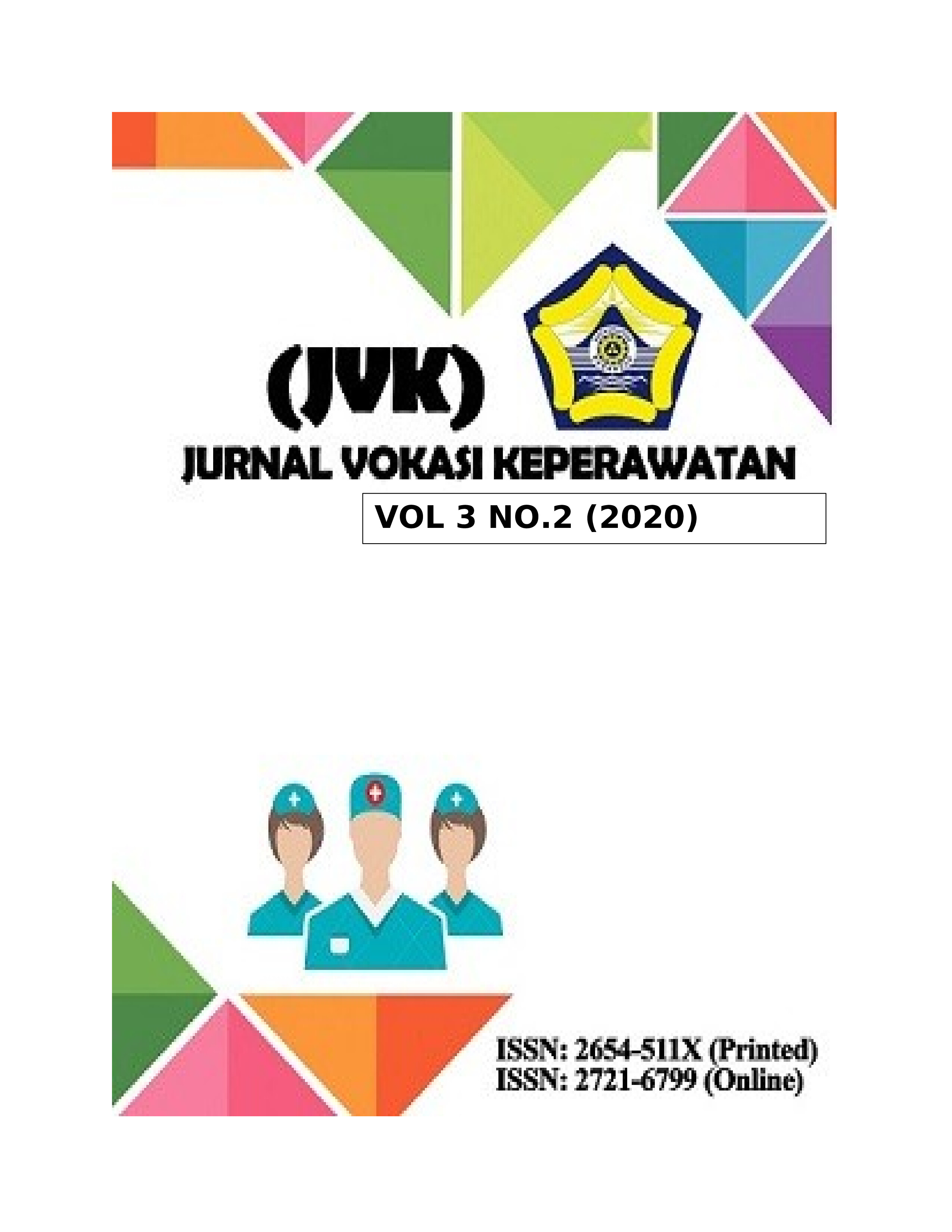Main Article Content
Abstract
The patient's risk of falling is an increased susceptibility to falls that can cause physical harm. Prevention of falling patients is carried out by means of assessment, the use of a yellow bracelet for a high fall risk; as well as conducting regular monitoring and evaluation. External factors that influence the implementation of fall risk prevention are organizational and management factors, work environment, team factors, staff factors, task factors, patient factors, and communication factors. Monitoring results obtained by nurses have provided fall prevention education, there are still bedrails that are not raised and there are high risk patients. From these data it can be concluded that the nurse has carried out the fall risk assessment properly but the implementation of fall prevention has not been optimal and there is a risk of falling patients. The purpose of this study was to determine the factors related to the risk of falling patients by nurses at Encik Mariyam Daik Lingga Hospital in 2019. This study used a descriptive analytical method with a cross sectional approach, the sample selection was carried out by using total sampling technique, the number of samples used was 32 respondents. The results were analyzed by using the chi square test and showed a relationship between factors, namely knowledge, attitudes and motivation of nurses with preventive measures for the risk of falling patients by nurses at RSUDEncik Mariyam Daik Lingga in 2019. Researcher's suggestions are that nurses can further improve knowledge, attitudes and motivation for good performance. especially in providing nursing care in the form of prevention of the risk of falling patients.
Keywords
Article Details
References
- Keputusan Menteri Kesehatan Republik Indonesia. (2017). Pusat Data dan Informasi Kemenkes RI, Situasi Tenaga Keperawatan Indonesia. Badan Pemberdayaan Sumber Daya Manusia Kesehatan. Diakses dari http://bppsdmk.kemkes. go.id.
- Notoatmodjo, S. (2014). Metodologi Penelitian Kesehatan. Jakarta: Rineka CiptaNotatmodjo. Promosi Kesehatan dan Ilmu Perilaku. Jakarta : Rineka Cipta
- Nursalam.(2016). Manajemen Keperawatan Aplikasi Dalam Praktik Keperawatan Profesional Edisi 3. Jakarta: Salemba Medika.
- Palomar Health. (2016.) Fall Prevention And Management Patient Safety. n.d. Diakses pada 10 Desember 2019 dari World Health Organization website: http://www.who.int/topics/patient_safety/en/.Permenkes tahun 1691/VIII/2011.
- Riesenberg, A, L., Leitzsch, J., & Cunningham, M. (2010). Nursing handoffs :A systemic review of the literature : surprisingly little is known about what constitutes best practice. American Journal of Nursing, 110(4), 24-34.
- Sanjoto, H. A. (2014.) Pencegahan Pasien Jatuh Sebagai Strategi Keselamatan Pasien : Sebuah Sistematik Review
- Severo, I.M. (2014). Risk Factors for Falls in Hospitalized Adult Patients:an Integrative review.,Rev E8c Enferm USP 2014; 48(3); 537-51.
- Sugiyono, P. D. (2015). Populasi dan sampel. Metode Penelitian Kuantitatif, Kualitatif Dan R&D.
- Syam, Y., Noersasongko, D., & Sunaryo, H. (2015). Fraktur Akibat Osteoporosis. E-CliniC, 2(2). doi.org/10.35790/ecl.2.2.2014.4885
- The Joint Commission. (2017). National Patient Safety Goals Effective January 2017. Nursing Care Center Accreditation Program
- Underprivileg, A., Motivation, M., Prodigies, I., Children, T., & Day, P. (2019). November 2019. (November), 16–18.
- Widoyoko, Eko. (2016). Teknik Penyusunan Instrumen Penelitian. Yogyakarta: Pustaka Pelajar.
- Watson, J, Barbara., et al.2016. The use of the Morse Fall Scale in an Acute Care Hospital, Health & Rehabilitation Sciences, Westren University, London
- Yedavally-Yellayi, S., Ho, A. M., & Patalinghug, E. M. (2019). Update on Osteoporosis. Primary Care - Clinics in Office Practice, 46(1), 175–190. doi.org/10.1016/j.pop.2018.10.014
- Yusup, F. (2018). Uji Validitas dan Reliabilitas Instrumen Penelitian Kuantitatif. Jurnal Tarbiyah?: Jurnal Ilmiah Kependidikan. doi.org/10.18592/tarbiyah.v7i1.2100
- Ziolkowski, D. (2014). Fall Prevention and Identification of Patients at Risk for Falling, diakses tanggal 10 Desember 2019 dari http://www.stjoesonoma. org/documents/StudentsInstructors/PVHFallPrevention. PDF
References
Keputusan Menteri Kesehatan Republik Indonesia. (2017). Pusat Data dan Informasi Kemenkes RI, Situasi Tenaga Keperawatan Indonesia. Badan Pemberdayaan Sumber Daya Manusia Kesehatan. Diakses dari http://bppsdmk.kemkes. go.id.
Notoatmodjo, S. (2014). Metodologi Penelitian Kesehatan. Jakarta: Rineka CiptaNotatmodjo. Promosi Kesehatan dan Ilmu Perilaku. Jakarta : Rineka Cipta
Nursalam.(2016). Manajemen Keperawatan Aplikasi Dalam Praktik Keperawatan Profesional Edisi 3. Jakarta: Salemba Medika.
Palomar Health. (2016.) Fall Prevention And Management Patient Safety. n.d. Diakses pada 10 Desember 2019 dari World Health Organization website: http://www.who.int/topics/patient_safety/en/.Permenkes tahun 1691/VIII/2011.
Riesenberg, A, L., Leitzsch, J., & Cunningham, M. (2010). Nursing handoffs :A systemic review of the literature : surprisingly little is known about what constitutes best practice. American Journal of Nursing, 110(4), 24-34.
Sanjoto, H. A. (2014.) Pencegahan Pasien Jatuh Sebagai Strategi Keselamatan Pasien : Sebuah Sistematik Review
Severo, I.M. (2014). Risk Factors for Falls in Hospitalized Adult Patients:an Integrative review.,Rev E8c Enferm USP 2014; 48(3); 537-51.
Sugiyono, P. D. (2015). Populasi dan sampel. Metode Penelitian Kuantitatif, Kualitatif Dan R&D.
Syam, Y., Noersasongko, D., & Sunaryo, H. (2015). Fraktur Akibat Osteoporosis. E-CliniC, 2(2). doi.org/10.35790/ecl.2.2.2014.4885
The Joint Commission. (2017). National Patient Safety Goals Effective January 2017. Nursing Care Center Accreditation Program
Underprivileg, A., Motivation, M., Prodigies, I., Children, T., & Day, P. (2019). November 2019. (November), 16–18.
Widoyoko, Eko. (2016). Teknik Penyusunan Instrumen Penelitian. Yogyakarta: Pustaka Pelajar.
Watson, J, Barbara., et al.2016. The use of the Morse Fall Scale in an Acute Care Hospital, Health & Rehabilitation Sciences, Westren University, London
Yedavally-Yellayi, S., Ho, A. M., & Patalinghug, E. M. (2019). Update on Osteoporosis. Primary Care - Clinics in Office Practice, 46(1), 175–190. doi.org/10.1016/j.pop.2018.10.014
Yusup, F. (2018). Uji Validitas dan Reliabilitas Instrumen Penelitian Kuantitatif. Jurnal Tarbiyah?: Jurnal Ilmiah Kependidikan. doi.org/10.18592/tarbiyah.v7i1.2100
Ziolkowski, D. (2014). Fall Prevention and Identification of Patients at Risk for Falling, diakses tanggal 10 Desember 2019 dari http://www.stjoesonoma. org/documents/StudentsInstructors/PVHFallPrevention. PDF
